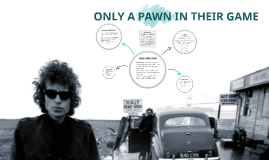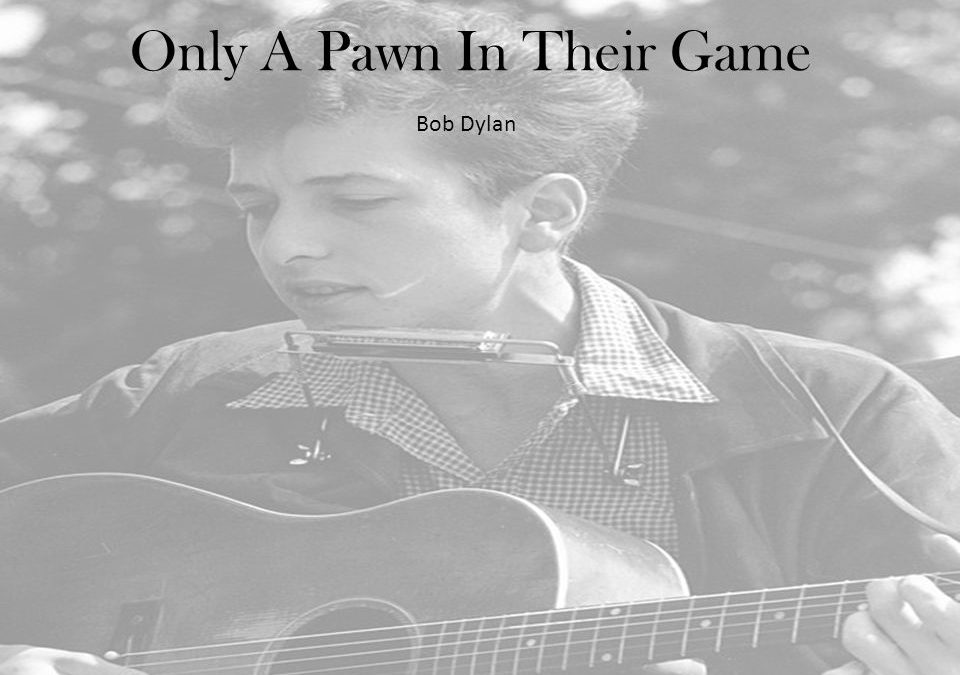“Only a Pawn in Their Game” is a song written by Bob Dylan about the assassination of civil rights activist Medgar Evers. Showing support for the African Americans during the American Civil Rights Movement. It was released on Dylan’s The Times They Are a-Changin’ album of 1964. The song suggests that Evers’ killer, Byron De La Beckwith does not bear sole blame for his crime, as he was only a pawn of rich white elites who incensed poor whites against blacks so as to distract them from their position on “the caboose of the train” in order create a more ‘perfect white American society’.
Dylan first performed “Only a Pawn in Their Game” at a voter registration rally in Greenwood, Mississippi. The song refers to the murder of Medgar Evers, who was the Mississippi leader of the NAACP. Civil rights activist Bernice Johnson would later tell critic Robert Shelton that “‘Pawn’ was the very first song that showed the poor white was as victimized by discrimination as the poor black. The Greenwood people didn’t know that Pete Seeger, Theodore Bikel and Dylan were well known. (Seeger and Bikel were also present at the registration rally.) They were just happy to be getting support. But they really like Dylan down there in the cotton country.”

Dylan sang the song at the 1963 March on Washington for Jobs and Freedom on August 28, at which Martin Luther King gave his “I Have a Dream” speech.
[wiki] https://en.wikipedia.org/wiki/Only_a_Pawn_in_Their_Game
On June 12, 1963, Bob Dylan’s career was just taking off when he heard the news that civil rights activist Medgar Evers had been assassinated. Dylan responded with a song that he eventually performed at the March on Washington and the Newport Folk Festival.
As Princeton University historian Sean Wilentz says, “Only a Pawn in Their Game” leans hard on the idea that Evers’ killer was not the only guilty party.
“The whole point is, the killer is guilty, yes, but he’s not the person to blame,” Wilentz tells NPR’s Audie Cornish. “There’s rather a much larger system that’s out there, and that’s what the song is really about.”
Dylan’s words also scrutinize the era’s white elites, suggesting they enraged poor whites against blacks in order to divert them from their own social and economic position.
“It’s a sort of standard left-wing take on what Southern segregation and racism was all about,” Wilentz says. “It isn’t simply a matter of hatred; it isn’t simply a moral question. It’s a political question and an economic question. The poor white man’s at the caboose of the train, but it’s the system — the rich, the powerful, everyone from the cops on up and down — they’re the ones who are twisting this guy’s head around with racism in order to keep him down.”
In the wake of such a tragic event, the song was a unique undertaking — one that aimed to communicate and understand what was taking place in the killer’s mind.
When Dylan wrote the song, the American civil rights movement was well under way, and protest songs such as “We Shall Overcome” were essential to the spirit of the movement. However, as Wilentz says, most protest songs were uplifting and encouraged an “eyes on the prize” mentality.
“Dylan’s writing a different kind of art,” Wilentz says. “Not just in the sense of art because it’s beautifully written, but because he actually had that ability to, as I say, enter into lots of different people’s brains and souls and see them in collision.”


Recent Comments